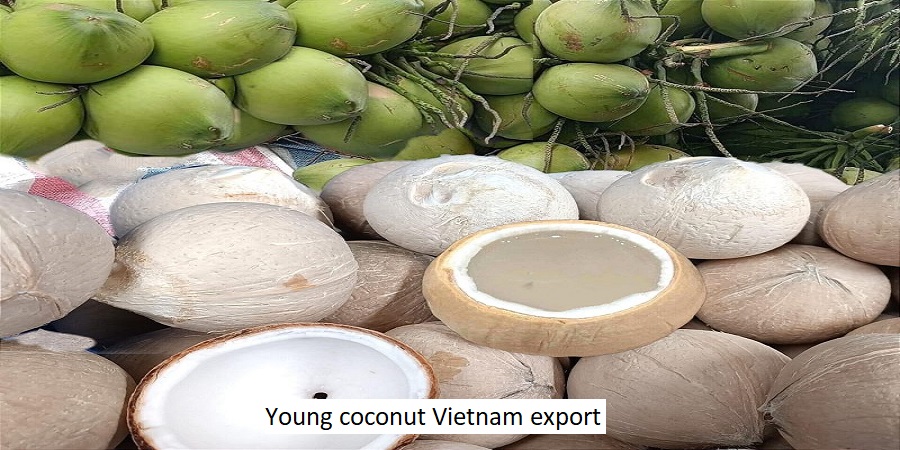
Young coconut Vietnam export daivietinternational.com The cultivation of young coconuts in Vietnam has gained significant attention, both domestically and internationally, due to its economic potential and export capabilities. The primary varieties of coconuts grown in Vietnam include the Green Dwarf and the Yellow Dwarf, which are prized for their tender flesh and refreshing water. These varieties are particularly sought after in markets such as Europe and North America, where consumer demand for healthy beverages continues to rise. The major coconut-producing regions in Vietnam are concentrated in the Mekong Delta, particularly in provinces such as Ben Tre, Tra Vinh, and Tien Giang. These areas, characterized by their fertile soil and ample water supply, provide an ideal environment for coconut cultivation.
Overview of Young Coconut Agriculture in Vietnam
The cultivation practices employed by local farmers reflect a blend of traditional techniques and modern agricultural advancements. Farmers typically plant coconut trees in well-drained soil, applying organic fertilizers to promote healthy growth. Irrigation systems are established to ensure that young coconuts receive adequate moisture, especially during prolonged dry spells. Additionally, integrative pest management practices are increasingly utilized to combat coconut pests and diseases, ensuring high-quality produce that meets international standards.
Vietnam’s tropical climate is another favorable factor contributing to the thriving young coconut industry. The warm temperatures and consistent rainfall create optimal conditions for growth, allowing farmers to harvest coconuts year-round. Young coconuts are deeply embedded in the rural economy, providing livelihood opportunities for countless families involved in farming, processing, and exporting. Beyond economic benefits, the cultivation of young coconuts also plays a crucial role in supporting local food systems and contributing to the agricultural diversity of the region.
Export Trends and Market Demand for Young Coconuts
The export of young coconuts from Vietnam has experienced significant growth in recent years, reflecting a broader trend towards natural, health-conscious products worldwide. Young coconuts are particularly sought after for their refreshing water and nutrient-rich flesh, making them a popular choice among consumers. Key importing countries, including the United States, Australia, and several European nations, have demonstrated a rising demand for high-quality coconut products. This trend is attributed to a shift in consumer preferences towards healthier beverages and organic food options.
As global health trends evolve, the appeal of young coconuts has surged, particularly among millennials and health enthusiasts who prioritize hydration and natural ingredients. In Vietnam, the production and exportation of young coconuts have been strategically developed to cater to this worldwide demand. The country’s favorable climatic conditions, combined with advancements in agricultural practices, have positioned it as a leading supplier of young coconuts in the international market.
Pricing dynamics within this market are influenced by various factors, including seasonal production variations, transportation costs, and import tariffs in key destination markets. Over the past few years, the pricing of young coconuts has seen fluctuations owing to these elements, affecting the competitiveness of Vietnamese exporters. The Vietnamese government and agricultural organizations have been proactive in promoting young coconut exports, focusing on quality enhancement and sustainable practices that meet global standards. This approach not only benefits farmers but also enhances Vietnam’s reputation in the global coconut supply chain.
In addition to changing consumer preferences, the rise in the popularity of coconut water as a natural sports drink has further stimulated demand. It is evident that the combination of health benefits, consumer awareness, and Vietnam’s robust agricultural capabilities will continue to drive the expansion of young coconut exports in the coming years.
Export Challenges Facing Young Coconut Producers
The young coconut export sector in Vietnam faces a myriad of challenges that significantly impede its potential for growth and global competitiveness. A primary concern is the inadequate infrastructure which hampers production and distribution. Many coconut-producing regions lack proper roads, storage facilities, and processing plants, which are essential for maintaining the quality of young coconuts during transport. This infrastructure deficiency not only delays the logistics involved in reaching markets but also increases operational costs, ultimately affecting the pricing strategies of exporters.
Logistics and transportation present additional hurdles. The nature of young coconuts, which are highly perishable, requires swift and efficient transport systems to ensure freshness upon reaching international markets. However, inefficiencies in logistics networks—such as insufficient cold storage options and unreliable shipping schedules—can lead to spoilage and loss of product quality, diminishing the reputation of Vietnamese exports.
Regulatory requirements also play a pivotal role in the challenges facing young coconut exports. Exporters must navigate a complex landscape of regulations both domestically and internationally. Compliance with health, safety, and quality standards can be burdensome for small-scale producers who may lack the resources or knowledge to effectively meet these requirements.
Moreover, competition from other coconut-producing countries such as the Philippines and Thailand further complicates Vietnam’s endeavors to advance its young coconut export industry. These nations often have more established markets, competitive pricing, and are better equipped to meet international standards. Concurrently, climate change poses an additional threat, impacting coconut agriculture through unpredictable weather patterns and increasing the risk of pest outbreaks, affecting both yield and quality. Addressing these various challenges is critical for young coconut producers in Vietnam to enhance their export capabilities and secure a larger share in the global market.
Related Articles: Nhà cung cấp dừa tươi số lượng lớn tại Việt Nam
Future Prospects and Strategies for Young Coconut Export Growth
The young coconut export sector in Vietnam holds considerable potential for growth, driven by increasing global demand for organic and health-conscious products. To enhance this growth trajectory, a multifaceted approach is essential, focusing on improving agricultural practices, increasing value-added processing, and establishing better market access. Innovations in cultivation techniques, such as organic farming and integrated pest management, can significantly increase both yield and quality while reducing environmental impact. Training local farmers in these advanced agricultural methods will contribute to higher productivity and sustainability.
Value-added processing of young coconuts is another critical step for boosting exports. By implementing processes such as coconut water extraction and production of coconut-based products like oils and creams, the export value can be enhanced. This not only allows for higher prices on international markets but also attracts consumers interested in culinary and health applications. Consequently, establishing processing facilities closer to coconut-growing regions can help create local employment opportunities while ensuring fresher products reach global markets quicker.
In addition, improving market access through participation in international trade fairs and digital platforms can open new avenues for Vietnamese young coconut products. Building relationships with international distributors and retailers will facilitate a deeper penetration into overseas markets. Furthermore, fostering international partnerships can lead to technology transfers, enabling local producers to adopt best practices from established coconut-exporting nations.
Additionally, embracing sustainable agricultural practices will appeal to environmentally conscious consumers, ensuring that Vietnam’s young coconut industry aligns with global market demands. Investment in research and development for innovative practices such as genetic improvement of coconut varieties can lead to higher resilience against pests and climate change impacts. Collectively, these strategies will not only secure a competitive edge for Vietnam in the global coconut market but also promote sustainable economic growth in rural communities dependent on coconut farming.
